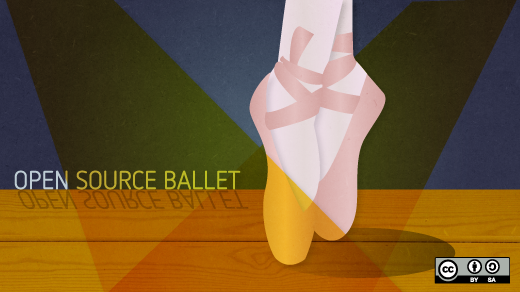Do open source software and ballet have anything in common? Sure, they have some obvious differences. But they share an imperative to collaborate and a creative spirit. Anyhow, I’m a big fan of both, and I’ve been thinking about whether some of the lessons of open source could be applied to ballet. Last week got a chance to kick ideas on this around with a great choreographer, Robert Weiss.
Weiss, who goes by Ricky, is artistic director of the Carolina Ballet, which plays out of Raleigh, N.C. He spent the early part of his career as a dancer at the New York City Ballet with its famous director, George Balanchine. In more than a decade with the Carolina Ballet, he has been a prolific choreographer, producing dozens of ballets. He’s also recruited superbly talented dancers from around the world and melded them into an outstanding company. When we met last week, along with my friend CB Board Chair Melanie Dubis, at Buku for lunch, I thought, this must be close to the world’s greatest job — working every day with beautiful, talented, dedicated people to create art for the ages. What could be more wonderful?
When we met for lunch last week, it quickly became clear that it would be more wonderful to not be constantly worried about money. If only, he said, he had better funding, he could spend more time thinking about dance and less about fund raising. Ballet is an art form that entails numbers of dancers, all requiring paychecks, and the same for musicians, costume designers and costumers, set designers and sets, lighting designers and lights, stage management and crew, and of course, choreographers. As an art, it is capital intensive. There are inherent barriers to reaching a wide audience, including lack of exposure to the form and its traditions.
As Ricky described the process of creating a new work, it was plain that it was highly collaborative. When he choreographs a new work, it is created on specific dancers, and the work is shaped in view of their individual qualities. The work draws on a tradition that goes back to the Renaissance, with a large vocabulary of movements that are available for re-use. (As Ricky warmed to the subject, he stood up from the table and showed a couple of classical gestures, and his sudden transformation from regular person to dancer was electrifying.) And of course, there’s collaboration with the aforementioned costume designers, set designers, and many others. It is in general an art of great idealism and unselfishness, at least in the sense that almost no one expects to get rich from it, and many are prepared to subsist on a shoestring budget.
But in ballet as in most of our endeavors, there is an unexamined assumption that intellectual property protection is important. Thus copying of videoed performances is subject to the draconian penalties of copyright law. The dances are kept locked down, on the assumption that making them freely available could result in lost value. I raised the question with Rocky and Melanie whether this really makes sense. Is copyright protection actually increasing the value proposition of ballet, or is it lessening it?
As I explained, the open source software community has learned some lessons about this that the rest of the world is starting to apply. Open source innovators, whose projects are based on freely sharing their code, realized that the traditional approach to intellectual property would not work for them, and so they created new licensing models, such as the GPL, that encouraged sharing and re-use. That approach has led to incredible growth in open source software. The model is spreading outward to other creative endeavors with such tools as Creative Commons licensing.
Could it be that less IP protectiveness could expand the audience for ballet and bring in new funding? What if, instead of protecting ballet as carefully as possible with copyright, the product was unlocked and made available under a Creative Commons license? For example, if well-produced video of the Carolina Ballet was readily available on the internet without charge, couldn’t that introduce many more people to ballet, with some of them eventually becoming balletomanes?
Ricky noted that even the best video of ballet is only a pale reflection of the experience of live performance. But he also admitted that he knew of people who had had transformative personal experience through a recorded performance. He also noted that it would require funding to make video recordings of a quality that he’d be comfortable presenting in public. (Footnote: a couple of days after our meeting, I saw a documentary on the choreographer Jerome Robbins called Something to Dance About, which is great, and illustrates how video can communicate something meaningful about dance.)
Open source innovation generally involves experimentation. I noted that there could be approaches to video and to funding that none of us has thought of yet. We agreed to talk more about what might be possible. It may be that you have ideas or experience in applying open source methods to artistic endeavors. If you have ideas, please share them.







3 Comments